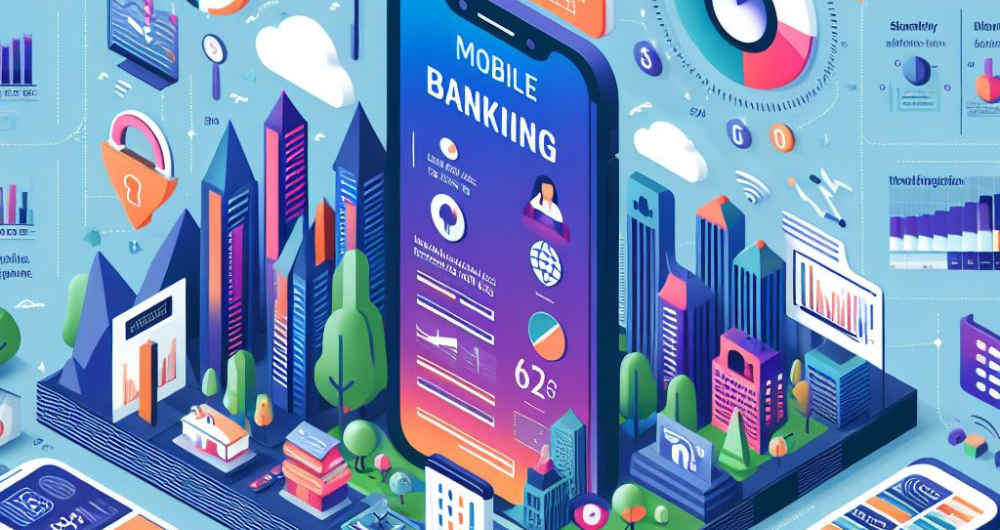
The journey of mobile banking from its inception to its current state is a testament to rapid technological advancement and changing consumer expectations. Initially, mobile banking was a basic service offering limited to account balance inquiries and transaction alerts. However, it has evolved into a comprehensive platform that supports a wide array of financial services, from real-time payments to sophisticated investment advice, all accessible from the palm of one’s hand.
In the United States, as well as globally, mobile banking has transitioned from a novelty to a necessity, driven by the demand for convenience, speed, and personalized banking experiences. This transformation has been accelerated by the COVID-19 pandemic, which pushed digital banking services from a complementary offering to a critical channel for banks to maintain continuity and service accessibility.
As we delve deeper into the nuances of mobile banking’s current landscape, key trends, and future predictions, it’s essential to keep in mind the underlying theme of transformation and adaptation. The banks that succeed in harnessing the potential of mobile banking will not only survive the digital shift but thrive, setting new standards for what consumers expect from their banking institutions.
Current Landscape of Mobile Banking
The current landscape of mobile banking is characterized by its widespread adoption and the increasing sophistication of the services offered. Mobile banking has become an integral part of the financial ecosystem, with a significant majority of customers using their smartphones to manage their financial lives.
Key characteristics of the current mobile banking landscape include:
- High Adoption Rates: The convenience and accessibility of mobile banking have led to high adoption rates among consumers of all ages. In the U.S., the Federal Reserve reports that over three-quarters of Americans have used mobile banking in some form, a number that continues to grow.
- Enhanced Security Measures: As the reliance on mobile banking has increased, so has the focus on security. Banks have implemented advanced security measures, such as biometric authentication and end-to-end encryption, to protect users’ information and transactions.
- Diverse Functionality: Today’s mobile banking apps offer a range of functionalities beyond basic account management. Users can apply for loans, invest in stocks, manage their budget, and even access AI-driven financial advice directly from their mobile devices.
- Integration with Fintech: Many banks have partnered with fintech companies to enhance their mobile banking services. These partnerships have enabled banks to offer innovative services, such as real-time payments and personalized financial insights, leveraging the agility and technology of fintechs.
- Customer Experience Focus: Banks have prioritized improving the user experience of their mobile banking apps. This includes intuitive design, personalized features, and responsive customer support, all aimed at making mobile banking as seamless and user-friendly as possible.
The current state of mobile banking reflects a dynamic and evolving sector, where innovation and customer-centricity are paramount. For banking professionals, staying abreast of these developments is crucial for devising strategies that align with consumer expectations and industry standards.
Key Trends Driving Mobile Banking in 2024
The mobile banking sector is rapidly evolving, shaped by broad banking trends and specific mobile advancements. In 2024, the push for instant, real-time services highlights a key trend, blending consumer demand with technology and regulation influences.
This shift towards mobile-first solutions underscores mobile banking’s growing significance and its trajectory towards more personalized and efficient experiences.

How General Banking Trends Specifically Impact Mobile Banking
- Real-Time Services in Mobile Banking: The push towards real-time services is particularly significant in mobile banking due to the inherently on-the-go nature of mobile devices. Customers expect to manage their finances, make payments, and receive instant notifications directly from their smartphones. This necessitates banks to integrate sophisticated real-time analysis and decision engines that can process transactions and data swiftly.
- Personalization through Mobile Channels: Mobile banking offers unique opportunities for personalization. By leveraging data from mobile app usage, location services, and customer interaction patterns, banks can create highly personalized and contextually relevant user experiences.
- AI and ML for Mobile Banking Enhancements: The integration of AI and ML is transforming mobile banking by enabling more sophisticated features such as predictive analytics for personal financial management, AI-driven customer support via chatbots, and enhanced security.
- Digital-Only Banking and Mobile First: The rise of digital-only banks highlights a trend towards mobile-first strategies. Traditional banks are increasingly focusing on mobile to deliver a comprehensive suite of services that can compete with the convenience and user experience of neobanks. This includes everything from account opening to loan applications being streamlined for mobile.
Additional Mobile-Specific Banking Trends
- Mobile Wallet Integration and Expansion: Beyond traditional banking services, mobile banking apps increasingly integrate with mobile wallets and payment systems to offer seamless payment experiences. This includes using NFC technology for contactless payments and integrating with third-party payment services for broader accessibility.
- Voice-Activated Banking Services: With the rise of voice-assisted devices, mobile banking also embraces voice commands. This trend is about enabling customers to perform banking tasks through voice-activated commands on their mobile devices.
- Augmented Reality for Enhanced Banking: Some banks are exploring augmented reality (AR) to provide customers with innovative services through their mobile apps. This could include AR for locating nearby ATMs or branches, visualizing potential savings growth, or simulating loan impacts on personal finances.
- Banking as a Service (BaaS) and API Integration: The trend towards BaaS and open banking APIs is particularly relevant for mobile banking as it allows banks to integrate financial services from various providers within their mobile apps.
- Enhanced Cybersecurity Measures: As mobile banking involves significant data exchange and financial transactions, enhancing cybersecurity measures is a critical trend. This includes adopting multi-factor authentication, encrypted communications, and secure app architectures to protect customer data and transactions.
Innovation in Mobile Banking Services
Banks increasingly adopt innovative services to enhance customer experience and operational efficiency in response to the key trends shaping the mobile banking landscape.
The following examples just glimpse how banks strive to innovate, underscoring the sector’s dynamic and forward-thinking nature.
- Advanced Analytics and Decision-Making Tools: A standout example of technological innovation in mobile banking is the integration of advanced analytics and real-time decision-making tools. Products like those offered by Latinia are pivotal, enabling banks to analyze customer data in real time. This capability allows instant decision-making, personalized product offerings, and fraud detection, directly addressing the customer’s demand for instant, secure, personalized banking experiences.
- AI-Driven Personalization: Artificial Intelligence (AI) is crucial in transforming how banks interact with their customers through mobile platforms. AI algorithms analyze customer behavior, preferences, and financial patterns to offer tailored advice, product recommendations, and financial planning tools. This level of personalization not only enhances the user experience but also boosts customer engagement and loyalty.
- Blockchain for Security and Efficiency: Blockchain technology is being explored for its potential to enhance security and operational efficiency in mobile banking. By enabling secure, transparent transactions and reducing the risk of fraud, blockchain offers a robust solution to some security concerns associated with mobile banking. Additionally, it streamlines operations by reducing transaction times and costs.
- Fintech Partnerships: Recognizing the innovation speed and agility of fintech companies, many banks are entering into partnerships. These collaborations allow banks to rapidly introduce new mobile banking services and features, such as seamless payments, budgeting tools, and investment services, further enriching the customer experience.
Strategic Impact of Emerging Technologies on Mobile Banking
Emerging technologies developed by tech companies significantly influence the dynamic evolution of mobile banking. These innovations are not only reshaping the present landscape of mobile banking but also setting the course for its future. The strategic impact of these technologies is profound, as they redefine efficiency, security, and the overall user experience.
Technological Advancements
Tech companies are at the forefront of developing cutting-edge technologies that offer new possibilities for mobile banking. Innovations in AI, machine learning, real-time analysis, blockchain, and cybersecurity are noteworthy. These technologies enhance the capability of mobile banking apps to offer personalized services, secure transactions, and real-time financial management solutions.
The Current Impact
These technological advancements are enabling banks to provide services that were once considered futuristic. For instance, AI-driven chatbots for customer service, blockchain for fraud prevention, and advanced analytics for personalized financial advice are becoming standard features in mobile banking apps. This improves operational efficiency and elevates the customer experience to new heights.
Future Forecast
Looking ahead, the integration of emerging technologies in mobile banking is expected to deepen further. We anticipate seeing more sophisticated uses of AI for personal financial management, broader adoption of blockchain for secure cross-border transactions, and the introduction of quantum computing for unparalleled data processing capabilities.
Moreover, continuous innovation in cybersecurity will be crucial in safeguarding against evolving digital threats, ensuring customer trust and regulatory compliance.
Customer Engagement and Personalization in Mobile Banking
Mobile banking offers an unparalleled opportunity for banks to elevate customer engagement and deliver personalized banking experiences. By leveraging the power of real-time analytics, banks can craft services that meet and anticipate customer needs, transforming the traditional banking relationship into a more personalized, engaging journey.

- Enhancing Customer Engagement: The key to enhanced customer engagement lies in understanding customer behaviors, preferences, and financial goals. Mobile banking platforms with real-time analytics can analyze transaction patterns, app usage data, and customer feedback in real-time. This analysis enables banks to deliver tailored notifications, advice, and product recommendations directly to the customer’s smartphone, making every interaction more relevant and engaging.
- Personalization Through Real-Time Analytics: Real-time analytics serve as the backbone of personalization strategies in mobile banking. These powerful tools allow banks to precisely segment their customer base, identifying unique needs and preferences. Whether it’s suggesting a budgeting tool to a customer who frequently exceeds their spending limits or offering a timely loan product to someone saving for a large purchase, real-time analytics ensure that the bank’s offerings resonate on a personal level.
- Transforming Customer Engagement: The impact of personalized experiences powered by real-time analytics is profound. Customers no longer feel like just another account number; instead, they receive a tailor-made banking service. This customized approach enhances customer satisfaction and fosters loyalty and trust. It encourages frequent interaction with the mobile banking app, making it an indispensable tool for daily financial management.
The Future of Personalization
Looking forward, the potential for personalization in mobile banking is boundless. Advances in AI and machine learning will enable even more sophisticated predictive analytics, allowing banks to anticipate customer needs before they arise. As banks continue to harness these technologies, we expect to see an era of hyper-personalized banking experiences seamlessly integrated into the customer’s lifestyle, further revolutionizing customer engagement in the mobile banking sector.
Challenges and Opportunities in Advanced Mobile Banking Solutions
The journey towards implementing advanced mobile banking solutions is fraught with challenges, yet each challenge presents distinct opportunities for innovation and growth. As banks navigate this complex landscape, understanding these hurdles and the potential they unlock is crucial for staying ahead in the competitive banking sector.
Challenges
- Security and Privacy Concerns: As mobile banking transactions increase, so do data security and privacy concerns. Banks face the daunting task of fortifying their systems against cyber threats while ensuring compliance with evolving data protection regulations.
- Technology Integration: Integrating new technologies into existing banking infrastructures can be complex and costly, requiring significant investment in time and resources.
- User Experience (UX) Design: Creating intuitive, user-friendly mobile banking interfaces that cater to a diverse customer base is challenging. Banks must balance functionality with simplicity to enhance user engagement without overwhelming users.
- Digital Literacy and Accessibility: Ensuring that mobile banking services are accessible and usable for all, including those with limited digital skills or access, remains a significant hurdle.
Opportunities
- Innovative Security Solutions: The challenge of security and privacy is driving innovation in encryption, biometric authentication, and blockchain technologies, offering banks new ways to protect customer data and build trust.
- Partnerships with Fintech and Tech Companies: The complexity of technology integration opens opportunities for banks to partner with fintech and tech companies, leveraging their expertise to accelerate innovation and expand service offerings.
- Enhanced Personalization through AI: Advanced analytics and AI offer opportunities to personalize banking experiences at scale, deepening customer relationships and fostering loyalty.
- Financial Inclusion: Mobile banking can potentially increase financial inclusion, reaching underserved populations with digital services that can improve their economic well-being.
By addressing these challenges head-on and exploring the opportunities they present, banks can enhance their mobile banking offerings and redefine the banking experience for their customers, paving the way for a more inclusive, secure, and customer-centric future in banking.
Future Predictions for Mobile Banking
The future of mobile banking, while building on today’s trends, is poised to embrace innovations and changes that we are only beginning to envision.
In the future, mobile banking could transcend the boundaries of financial transactions and account management to become an integral part of a broader, interconnected digital ecosystem. This vision includes seamless integration with the Internet of Things (IoT), where banking services are not just at your fingertips but embedded in the fabric of daily life—responsive to voice commands, wearable technology, and even connected vehicles.
Moreover, it won’t be confined to mere transactions or financial management but will evolve into a central hub for a holistic digital lifestyle. This means banks will have the opportunity to analyze both online and offline activities, offering hyper-personalized experiences that cater to individual customer needs and preferences in real time.
The notion of banking could expand to encompass not just money management but also the stewardship of digital identities, assets, and even one’s carbon footprint, reflecting a growing societal emphasis on sustainability and personal responsibility. Blockchain and other decentralized technologies might redefine the concept of trust in banking, allowing for more transparent and equitable financial systems.
Artificial Intelligence (AI) will likely continue to evolve, offering predictive insights into financial behaviors and life events and suggesting financial strategies tailored to individual life paths. These advancements could herald a shift towards more proactive financial planning tools banks offer, anticipating needs and offering solutions before the customer even identifies a requirement.
The role of banks in the broader economic and social fabric could evolve significantly. Banks might become orchestrators of a wide array of services, extending beyond traditional banking to include healthcare, education, and government services, all accessible through mobile banking platforms. This integration could lead to a more holistic approach to customer service, where financial well-being is just one aspect of a broader spectrum of well-being addressed by mobile banking.
In the future, challenges related to privacy, security, and digital literacy will become even more critical, necessitating innovative solutions and proactive regulatory frameworks.
Thus, as we look toward the future of mobile banking, we anticipate technological advancements and reimagining what banking means in an increasingly digital, interconnected, and conscientious world.
Conclusion
As we navigate the rapidly evolving landscape of mobile banking, it’s clear that staying ahead requires not only an awareness of current trends and technologies but also a forward-thinking approach that anticipates the needs and desires of tomorrow’s consumers.
Banks need to embrace innovation, personalize customer experiences, and ensure the security and efficiency of their services to remain competitive in a future where mobile banking is deeply integrated into daily life.
In this context, Latinia emerges as a pivotal partner for banks aiming to lead in the mobile banking sector. With our advanced real-time analysis and decision engines, Latinia equips banks with the tools they need to deliver highly personalized banking experiences, make data-driven decisions instantly, and enhance customer engagement in meaningful ways. Our solutions are designed to help banks exceed the expectations of modern consumers, paving the way for a future where banking is seamless, secure, and deeply integrated into the fabric of customers’ lives.

For banks looking to stay ahead in this dynamic environment, partnering with Latinia offers a strategic advantage. We invite you to explore how our innovative solutions can transform your mobile banking services and keep you at the forefront of the industry. Contact us or request a demo today to learn more about how Latinia can help your bank confidently navigate the future of mobile banking.
Categories: Trends
